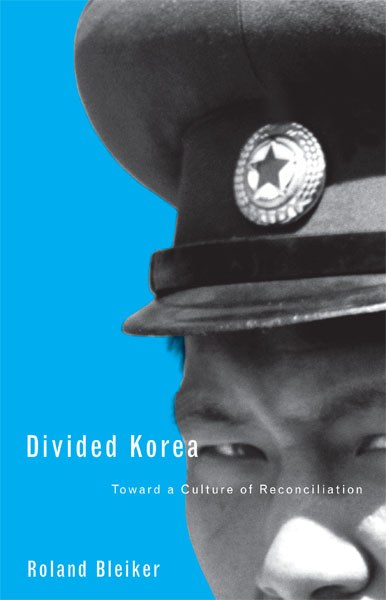
- Free Article: No
- Contents Category: History
- Review Article: Yes
- Article Title: Kim Il Sung’s trousers
- Online Only: No
- Custom Highlight Text:
‘The US scares North Korea.’ If you are George W. Bush or Dick Cheney, you may be satisfied with this statement by former US diplomat Donald Gregg. It might signify the success of American policy towards North Korea, a country you consider to be a dangerous ‘rogue state’ that is developing nuclear weapons and exporting missile technology, and that is led by a repressive totalitarian régime. The only way to deal with such governments, you believe, is through threats, deterrence and, if necessary, military action to degrade offensive military capabilities or even to remove them from power. But what if this brings us to the brink of disaster? In this timely and important book, Roland Bleiker exposes this schoolyard philosophy for what it is: a dangerous and simplistic recipe that has brought North-East Asia to the brink of war too many times in recent years. Ever since the North Koreans announced in 2002 that they were withdrawing from the Treaty on the Non-Proliferation of Nuclear Weapons (NPT) and were on the brink of developing a working nuclear capability other countries in the region have been justifiably alarmed.
- Book 1 Title: Divided Korea
- Book 1 Subtitle: Toward a culture of reconciliation
- Book 1 Biblio: University of Minnesota Press, US$27.95 hb, 227 pp
- Book 1 Cover Small (400 x 600):

- Book 1 Cover (800 x 1200):

In explaining how things got to this point, Bleiker does the reader a great service by combining a critical account of recent nuclear crises and North Korean brinkmanship with a deeper analysis of their underlying causes. In turn, he offers some challenging paths toward a more durable solution. He does so in an engaging and accessible style that never loses sight of the real-world challenges we face. He has produced a book that will keep the attention of all interested readers, especially those close to the policy process.
The first half of the book develops a high-quality critique of the two recent nuclear crises, locating their source not merely in North Korean recalcitrance but in a pattern of US threats and South Korean policy. While not excusing the North Korean régimes for their many broken promises, provocative acts and suppressions of human freedoms, Bleiker also presents a perspective that in some circles amounts to heresy: he dares to ask how the situation looks from their side of the Demilitarised Zone (DMZ).This makes for a spine-tingling Chapter 3, when we are asked to consider the psychological impact of the US stationing nuclear forces and 40,000 of its own troops in South Korea and annual military exercises based on an aggressive scenario of ‘bold and vigorous strikes into the enemy’s rear’. This, Bleiker reminds us, follows the use of nuclear weapons close to Korea at Hiroshima and Nagasaki in 1945, and the deliberate targeting of North Korea as part of the 1950s ‘massive retaliation’ doctrine. Until they were withdrawn in 1990, US nuclear weapons were kept close to the border and were even flown routinely to the edge of the DMZ in training exercises.
Fast forward to 2002, when Bush names North Korea and Iraq as part of an ‘axis of evil’ in February, releases a Nuclear Posture Review in June that includes the use of pre-emptive nuclear strikes against rogue states, and underlines the threats in September’s National Security Strategy. By the time it has deployed several divisions to the Persian Gulf in February 2003, the US looks like it means business. Bleiker plausibly presents North Korea’s October 2002 decision to eject international inspectors as a rational defensive strategy designed to draw concessions from the US or, if that failed, to equip it with the ultimate deterrent against attack. Bush’s administration ought to have remembered Kim Il Sung’s comment to Cambodia’s King Sihanouk during the first crisis: ‘They want to take off our shirt, our coat and now our trousers.’ The events of 2002 were particularly tragic given that there had been an historic summit between the two Korean leaders in 2000, a dramatic softening of rhetoric and attitudes, and new initiatives for aid, cooperation and people-to-people exchanges.
Rather than merely calling for more sensitive diplomacy, Bleiker challenges the entire security paradigm that underpins the conflict and that leads to constant setbacks. Notwithstanding the obvious military insecurity felt by all sides, Bleiker’s most important contention is that the real driving factor is identity – the deeply antagonistic identity-constructs, developed over five decades, which portray the other side as ineradicably threatening and evil. He argues that conventional strategic and diplomatic responses will always fail because they don’t address the underlying alienation and misperceptions that, when combined with the self-perpetuating cycle of military threats, keep the region on the brink of war.
This leads Bleiker, in the book’s second half, to develop a far-reaching analysis of approaches that might help to resolve the underlying conflict. This means involving ordinary citizens as much as diplomats, and promoting better communication, understanding and dialogue. While these are a standard part of the liberal diplomatic armoury, one of Bleiker’s most interesting challenges is to an assumption in Kim Dae Jung’s 1990s ‘Sunshine Policy’ that the resolution of the conflict should result in the reunification of the country around a liberal economy and political system. As attractive as this seems, Bleiker adds a note of caution, pointing to the difficulties and alienation experienced by North Korean defectors and the generally threatening quality of this agenda to the communist régime. Instead, he urges the adoption of an ‘ethics of difference’ that dismantles antagonistic identities but accepts that they cannot ‘be merged into one common form of identity, at least in the near future’.
It is sobering to consider that Australia’s 2003 defence white paper strongly endorses the pre-emptive war approach of the US neo-conservatives. While I can highly recommend this book to any concerned reader, I would especially recommend it to two: Alexander Downer and Condoleezza Rice.


Comments powered by CComment